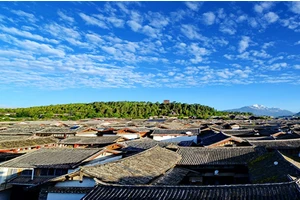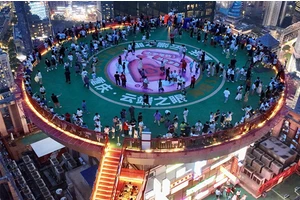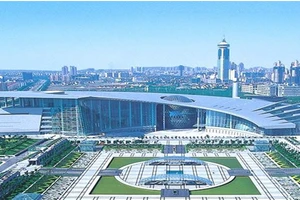Tourism market situation
The number of travel agencies in China continues to grow.
According to the data of the Ministry of Culture and Tourism, although the epidemic has had a great negative impact on the tourism industry since 2020, the number of travel agencies in China has continuously increased from less than 39,000 in 2019 to 42,400 in 2021, an increase of 4.3% over 2020.
The number of employees in China travel agencies continues to decline.
Different from the increasing number of travel agencies, the number of employees of travel agencies in China decreased from 415,900 in 2019 to 278,800 in 2021, which was 13.55% lower than that in 2020.
In 2021, the total number of domestic tourists in China increased by 12.8% year-on-year
In 2021, the total number of domestic tourists in China was 3.246 billion, up 12.8% year-on-year, but it was still far lower than the 5.901 billion in 2019 before the epidemic, and only recovered to 54.0% in 2019. In 2021, urban residents made 2.342 billion domestic trips, an increase of 13.4%; Rural residents made 904 million domestic trips, an increase of 11.1%.
In 2021, the total domestic tourism consumption in China increased by 31%.
In 2021, the total domestic tourism consumption income in China was 2.92 trillion yuan, an increase of 31.0% compared with 2020, but far lower than 5.73 trillion yuan in 2019. In 2021, the total domestic tourism consumption of urban residents was 2.36 trillion yuan, an increase of 31.6% over 2020; The total tourism consumption of rural residents was 0.55 trillion yuan, an increase of 28.4% compared with 2020.
In 2021, the online travel transaction in China reached 1.47 trillion yuan.
According to Fastdata data, the online travel market in China began to recover in 2021, and the annual transaction volume in 2021 was 1.47 trillion yuan, an increase of 34.9% compared with 2020, but it still did not recover to the level in 2019.
To sum up, the number of travel agencies in China has increased rather than decreased since the outbreak, but the number of travel agency employees has continued to decline. From the data of total domestic tourist arrivals and total consumption in 2021, the industry shows signs of recovery. In 2021, the total number of domestic tourists in China was 3.246 billion, a year-on-year increase of 12.8%; Total tourism consumption reached 2.92 trillion, up 31.0% year-on-year; The online travel transaction volume reached 1.47 trillion, a year-on-year increase of 34.9%.
—— The above data refer to the Analysis Report on Market Foresight and Investment Strategic Planning of China Tourism Industry by Forward-looking Industry Research Institute.
With the development of society, tourism has become one of the strongest and largest industries in the global economy. The industrial position and economic role of tourism in urban economic development are gradually strengthened, and its pulling effect on urban economy, driving force of social employment and promoting effect on culture and environment are increasingly apparent. Tourism is one of the pillar industries of China's economic development.
In 2008, China's tourism industry was continuously impacted by the financial crisis, various unexpected events and unfavorable factors, and experienced an unprecedented test. Facing the severe market situation, China's tourism industry has maintained a steady development as a whole. In the whole year, 130 million inbound tourists were received, and the foreign exchange income of international tourism reached 40.843 billion US dollars, down by 1.4% and 2.6% respectively over the previous year. The number of domestic tourists was 1.712 billion, and the income was 874.930 billion yuan, up 6.3% and 12.6% respectively over the previous year. The number of China citizens leaving the country reached 45.8444 million, an increase of 11.9% over the previous year; The total tourism revenue was 1.16 trillion yuan, an increase of 5.8% over the previous year.
In the first three quarters of 2009, China's tourism industry withstood the huge impact of the international financial crisis and influenza A (H1N1), and the favorable factors in the operation of tourism economy increased significantly, with a good overall growth momentum. The three major markets maintained a pattern of "two liters and one drop". In the domestic market, in the first three quarters of 2009, the number of domestic tourists was 1.45 billion, up 11% year-on-year, and the domestic tourism revenue was 740 billion yuan, up 10% year-on-year. In terms of inbound market, the number of inbound tourists in the first three quarters of 2009 was 94 million, down 3% year-on-year, and the foreign exchange income of inbound tourism was 28 billion yuan, down 7% year-on-year. In terms of outbound market, preliminary statistics show that the number of outbound tourists in the first three quarters of 2009 was 35 million, a year-on-year increase of 2.4%. From the perspective of industrial fundamentals, China's tourism industry is in a state of overall recovery, its operating conditions have been greatly improved, tourism employment has remained stable and tourism investment has continued to be active. The prosperity of the tourism industry is in a state of comprehensive and substantial recovery.
Although the financial crisis in 2008 brought about the weakness of global aggregate demand and adversely affected China's tourism industry, the major opportunities and basic environment faced by China's tourism industry have not changed, and the overall development trend of tourism industry cannot be changed or reversed. The fundamentals of China's economic and social development have not changed, and the driving force of tourism development is still strong. China's opening to the outside world continues to expand, various reforms are steadily advanced, the income of urban and rural residents continues to grow, and the potential of residents' tourism consumption demand is still huge. The solid foundation laid in the 30 years of reform and opening up will strongly support the development of China's tourism industry.
At the same time, on December 1, 2009, the State Council's Opinions on Accelerating the Development of Tourism was officially released, which proposed for the first time "to cultivate tourism into a strategic pillar industry of the national economy", and the five measures put forward pointed out the upgrading direction of the tourism industry. This will bring new development opportunities for China's tourism industry. It is predicted that the recovery trend of China's tourism industry will be obvious in 2010, and the growth rate of the industry will increase to 16.5%, and the industry will return to rapid growth.
The Report on Investment Analysis and Forecast of China Tourism Market in 2010-2015 issued by CIC Consultants consists of 22 chapters. Firstly, this paper introduces the definition, types, industrial characteristics and position of tourism in the national economy, then analyzes the related industries and factors to promote the development of tourism and the current situation of international and domestic tourism, and makes a detailed analysis of the inbound tourism market in China. Then it introduces the development of eco-tourism, golden week tourism, red tourism, hot spring tourism, tourist towns, theme parks, incentive tourism, industrial tourism, agricultural tourism, science and technology tourism and self-driving tourism. Subsequently, the report made market segmentation and consumer analysis, e-commerce application and construction analysis, tourism resources analysis, industry competition analysis, industrial chain composition and value analysis, business model analysis, information development analysis and investment analysis. Marketing refers to the overall enterprise activities of an enterprise to adapt to and meet the needs of consumers, from product development, pricing, publicity and promotion to delivering products from producers to consumers, and then feeding back the opinions of consumers to the enterprise. The business orientation of an enterprise has gone through five stages: production orientation, product orientation, sales orientation, marketing orientation and social marketing orientation. Tourism marketing is a process of analysis, planning, implementation, feedback and control to coordinate various tourism economic activities based on tourism consumption demand, so as to achieve the economic and social goals of providing effective products and services, satisfying tourists and making enterprises profitable.The starting point of tourism marketing research is the needs of tourism market, and the purpose of research is to obtain benefits. It can be seen that tourism marketing is an important link to obtain benefits and plays an important role in developing tourism. Second, the development status of tourism marketing China, as the first country in the world in tourism resources, has the largest domestic tourism market in the world and will become the largest destination country in the world in 2020. Under this two-way interaction between supply and demand, the consumption demand in China's tourism market has been continuously increased, and there is great room for the development of national outbound tourism. In particular, the extension of paid holidays has enabled people to have more leisure time, and the growth of per capita income has enabled people to have more "disposable income", which has created more conditions and opportunities for Chinese citizens to travel. At the same time, with the gradual development of China's tourism industry and the increase of people's travel times, people's consumption in tourism has become rational, personalized and diversified. However, in this booming tourism market, there are some problems in China's tourism marketing, such as blind price-cutting competition, low scientific and technological content of marketing strategy, lack of attention to after-sales service, failure to form good customer relations, and weak legal awareness. Therefore, in order to form a strong market competitiveness, China's tourism industry must flexibly use the concept of destination integrated marketing (IMC), change the focus of marketing thinking, and shift from 4PS (products, prices, promotions and channels) to 4CS (customers, costs, convenience and communication), establish an outside-in marketing planning model, and do a good job in marketing.Especially, the arrival of the Olympic Games has brought greater opportunities for China's tourism industry and tourism marketing. At this good opportunity, China's tourism marketing will develop more scientifically, healthily, rapidly and continuously. Third, the future development trend of tourism marketing (1) Accelerate the development of tourism network marketing 1. Vigorously develop network marketing. With the rapid development of network and e-commerce, the competition in the tourism market is becoming increasingly fierce and the marketing strategies are diversified. The tourism industry has also actively changed its old ideas and squeezed into the tide of online marketing. Tourism network marketing is a marketing activity using the carrier of electronic network. It is to use the Internet to subdivide and target the tourism market more effectively, to plan and implement the distribution, channels, product pricing, services and product concepts more effectively, and to create transactions between tourists and sellers of tourism products. Tourism development network marketing has two advantages: first, tourism product is a special service product, which has the characteristics of synchronous production and consumption, long-distance consumption in different places, and consumers can't perceive the product in advance, making it one of the most suitable product types for online inquiry, browsing and purchase; Second, the network has the advantages of rich information sources, fast delivery, wide coverage, strong autonomy, timely response and more reasonable operation mode, which can effectively reduce the production, marketing and sales costs of products and save customers' energy, time and capital costs. From this, we can see that vigorously developing online marketing is one of the inevitable trends of tourism marketing model, especially after China's successful Olympic bid.The huge market brought by the Olympic Games brings a rare opportunity for tourism network marketing. 2. Network marketing and traditional marketing need to be closely combined. From the development trend, the implementation of network marketing is inevitable, but it is undeniable that China's network marketing is still in a low stage, and there are many problems such as the authenticity and update speed of information sources, network security, etc., which makes tourism network marketing unable to fully play its advantages and become a bottleneck restricting the development of tourism marketing in China. In this transition period, only by closely combining online marketing with traditional marketing, can we meet the needs of customers better, faster and more efficiently, and develop tourism marketing better, thus promoting the prosperity of the tourism market. (II) Strengthening Green Marketing to Promote the Sustainable Development of Tourism With the increasing awareness of global environmental protection, all countries in the world are implementing sustainable development strategies, emphasizing that economic development should be coordinated with environmental protection, and people are beginning to pursue more environmentally friendly and sustainable green consumption and green marketing. The so-called green marketing refers to the marketing concepts, marketing methods and marketing strategies that enterprises take environmental protection as their guiding ideology, green culture as their values and green consumption of consumers as their center and starting point. It requires enterprises to implement the principle of combining their own interests, consumer interests and environmental interests in their operations. Tourism "is a resource-based industry, relying on natural gifts and social heritage", but in reality, tourism has been questioned as a "smokeless industry". "Tourists take only photos and leave only footprints". With the advancement of tourism,Too many picturesque but sensitive environments in the world have been destroyed, and the problems have become more and more complicated. These phenomena are detrimental to environmental resources and directly affect the development of tourism itself. Therefore, China's tourism industry must take the road of sustainable development and strengthen green marketing. First of all, establish a green marketing concept centered on resource values. Secondly, determine the green marketing objectives. Thirdly, establish a green marketing mix strategy. On the basis of establishing the concept and goal of green marketing, the tourism industry always implements the green principles in the design, price, packaging, distribution, promotion and sales service of tourism products, and applies them scientifically. Finally, carry out green certification. Since 1993, the International Organization for Standardization has formulated a series of international standards for environmental management (ISO14000), which greatly promoted the development of tourism green marketing. For example, the activities of creating "green hotels" in Zhejiang and Shandong provinces and the ISO14000 certification in Wuyishan Scenic Area have injected new contents into the green marketing of tourism. Strengthening the development of green tourism marketing is to make the tourism industry truly friendly and harmonious with the environment, to conform to the trend of tourists returning to nature and caring for the tourism ecological environment, and to take the tourism industry.
The road of sustainable development is a marketing strategy with great vitality. (3) Dig deep into the connotation of tourism culture and carry out tourism brand marketing. Modern enterprises pay more and more attention to brand building, and marketing with brand as the core has become the core of modern enterprise competition. Brand marketing refers to the marketing strategy and process that enterprises create brand value and finally form brand benefits by making use of consumers' brand demand. The essence of China's tourism brand building should lie in a long history and rich culture, but at present, the brand marketing of China's tourism industry is far from enough to explore the cultural connotation of tourism products, which leads to the ineffective extension of the life cycle of tourism products. Therefore, we must first dig deep into the connotation of tourism culture in order to make tourism products invincible. For example, the theme park on the Riverside at Qingming Festival in Kaifeng, Henan Province is the reappearance of the Riverside at Qingming Festival by Zhang Zeduan, a famous painter in the Song Dynasty. It is precisely because this theme park has well excavated the connotation of history and culture that it can develop with an average annual benefit of more than 15 million yuan when the tourism of theme parks in China is at a low ebb. At the same time, it should be noted that "deep" mining is a gradual process, and it is also a process that needs to be constantly integrated with innovative factors, not a constant continuation of the original foundation. Secondly, the main task of brand marketing is to develop and design tourism products on the basis of deeply excavating the connotation of tourism culture, and to shape and spread the brand image. According to China's tourism culture, plan a brand image with China characteristics, and endow the brand of tourism products with strong vitality.Then, according to various factors such as the requirements of successfully shaping the brand target image, the target market situation and its own comprehensive conditions, we should scientifically and reasonably choose and combine the communication methods. The selected and combined communication methods should be able to fully, accurately and intuitively show the characteristics of the brand target image, and at the same time, we should fully consider the economic conditions of the enterprise, pay attention to the research on the input and output benefits, and try to spend the least money to achieve the maximum effect. In addition, the tourism public sector (government and tourism administrative departments) should also play a certain role, focusing on the overall promotion of regions, provinces and the whole country in marketing, thus promoting the orderly and healthy development of tourism.
Prev: About tourism investment
Next: Winter tourism in Lhasa






